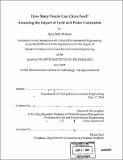| dc.contributor.advisor | Dennis B. McLaughlin. | en_US |
| dc.contributor.author | Watson, Amy Beth, 1980- | en_US |
| dc.contributor.other | Massachusetts Institute of Technology. Dept. of Civil and Environmental Engineering. | en_US |
| dc.date.accessioned | 2005-10-14T20:18:27Z | |
| dc.date.available | 2005-10-14T20:18:27Z | |
| dc.date.copyright | 2004 | en_US |
| dc.date.issued | 2004 | en_US |
| dc.identifier.uri | http://hdl.handle.net/1721.1/29394 | |
| dc.description | Thesis (S.M.)--Massachusetts Institute of Technology, Dept. of Civil and Environmental Engineering, 2004. | en_US |
| dc.description | Includes bibliographical references (p. 121-126). | en_US |
| dc.description.abstract | Land and water resources are becoming increasingly scarce in China, threatening the nation's ability to feed its growing population. The limitations of these resources must be considered simultaneously to determine China's ability to produce food. In this thesis we present an optimization model to identify the maximum population that can be sustainably supported subject to land and water constraints. This model can be used to inform water resource management decisions. The optimization model specifies the spatial allocation of cropland and water, subject to various physical constraints. As more land is used for crops, more water is consumed by agriculture. The model's water constraints are based on steady- state, annual water balances for major river basins and precipitation and evapotranspiration climatology. The movement of water is constrained by a coarse resolution stream network within each river basin. Food produced within each river basin may be consumed anywhere within China. The model's land constraints are based on reported values for total and irrigated cropland. The irrigated cropland constraint can be relaxed to examine production increases due to possible expansion of irrigated infrastructure beyond current levels. The use of this model is demonstrated with preliminary data. The results suggest that China can support 693 million people sustainably with its resources, assuming current levels of crop imports. Expanding irrigation infrastructure to all cropland enables China to support 828 million people. The model proves to be highly sensitive to oil crop consumption and crop growing period inputs. Sensitivity to data inputs contributes to the uncertainty of model results. Further refinement of the model and improved data should result in improved population predictions. | en_US |
| dc.description.statementofresponsibility | by Amy Beth Watson. | en_US |
| dc.format.extent | 126 p. | en_US |
| dc.format.extent | 4894874 bytes | |
| dc.format.extent | 4894679 bytes | |
| dc.format.mimetype | application/pdf | |
| dc.format.mimetype | application/pdf | |
| dc.language.iso | eng | en_US |
| dc.publisher | Massachusetts Institute of Technology | en_US |
| dc.rights | M.I.T. theses are protected by copyright. They may be viewed from this source for any purpose, but reproduction or distribution in any format is prohibited without written permission. See provided URL for inquiries about permission. | en_US |
| dc.rights.uri | http://dspace.mit.edu/handle/1721.1/7582 | |
| dc.subject | Civil and Environmental Engineering. | en_US |
| dc.title | How many people can China feed? : assessing the impact of land and water constraints | en_US |
| dc.type | Thesis | en_US |
| dc.description.degree | S.M. | en_US |
| dc.contributor.department | Massachusetts Institute of Technology. Department of Civil and Environmental Engineering | |
| dc.identifier.oclc | 56131807 | en_US |
